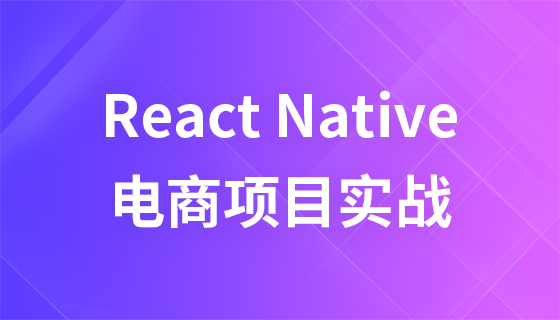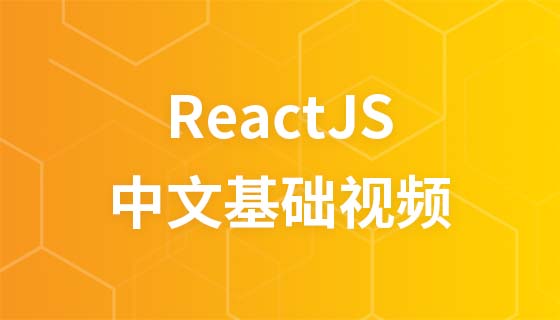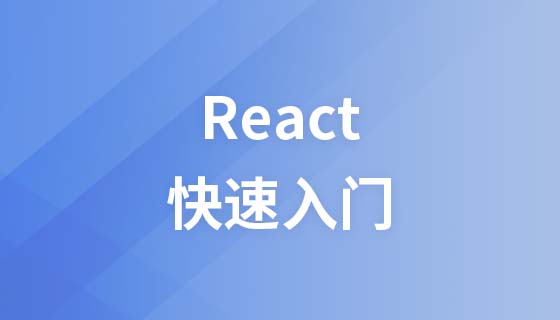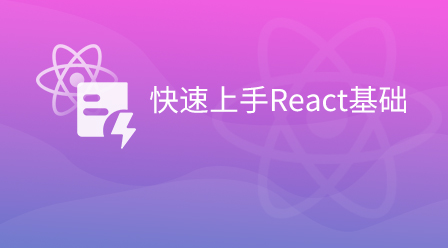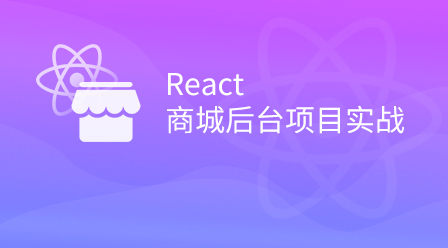react管理狀態的工具:1、利用hooks進行狀態管理;2、利用Redux進行狀態管理,這種方式的配套工具比較齊全,可以自訂各種中介軟體;3、利用Mobx進行狀態管理,它透過透明的函數響應式程式設計使得狀態管理變得簡單且可擴展。

本教學操作環境:Windows7系統、react17.0.1版、Dell G3電腦。
jQuery 時代,JS 程式碼中混雜 DOM 結構,各個流程龐雜交織時,就形成麵條式程式碼,當使用發布訂閱模型時,調試會一團亂麻。
jQuery 是針對 "過程" 的命令式編程,而那麼多命令,最終都是為了更新 UI 中的 "資料",為什麼不直接去改資料呢?
北京 → 上海,把 city="北京" 變成 city="上海" 就好。不管飛機火車步行拋錨,也不管路上會不會遇到王寶強,
現代前端框架的意義,就是問題解決思路的革新,把對"過程" 的各種命令,變為了對"狀態" 的描述。
什麼是狀態? 狀態就是 UI 中的動態資料。
2013 年 5 月 React 誕生。但 2015 年之前,大概都是 jQuery 的天下。 2015 年 3 月 React 0.13.0 發布,帶來了 class 元件寫法。
在 React class 元件時代,狀態就是 this.state,使用 this.setState 更新。
為避免一團亂麻,React 引入了 "元件" 和 "單向資料流" 的概念。有了狀態與元件,自然就有了狀態在組件間的傳遞,一般稱為 "通訊"。
父子通信較簡單,而深層、遠距離組件的通信,則依賴 "狀態提升" props 層層傳遞。
於是,React 引入了 Context,一個用於解決元件 "跨級" 通訊的官方方案。
但 Context 其實相當於 "狀態提升",並沒有額外的效能優化,寫起來比較囉嗦。
為最佳化效能,一般會增加多個 Context,寫起來就更囉嗦。在專案沒那麼複雜時,不如層層傳遞簡單。
實用主義來說,"狀態管理" 就是為了解決元件間的 "跨級" 通訊。
當然,在使用狀態管理函式庫時,會帶來一些衍生的思維模式,例如如何組織state,如何分割公共邏輯、業務邏輯、元件邏輯等,但歸根究底,這些都不是核心緣由。
核心就是為了解決實際問題 —— 為了溝通。其它的各種概念與哲學,都不是必要的。
Context 沒那麼好用,React 官方也沒什麼最佳實踐,於是一個個社群庫就誕生了。
目前比較常用的狀態管理方式有hooks、redux、mobx三種,下面我將詳細介紹一下這三類的使用方法以及分析各自的優缺點,以供各位進行參考。
用hooks進行狀態管理主要有兩種方式:
useContext useReducer
# #使用方法
1.建立store和reducer以及全域contextsrc/store/reducer.tsimport React from "react";
// 初始状态
export const state = {
count: 0,
name: "ry",
};
// reducer 用于修改状态
export const reducer = (state, action) => {
const { type, payload } = action;
switch (type) {
case "ModifyCount":
return {
...state,
count: payload,
};
case "ModifyName":
return {
...state,
name: payload,
};
default: {
return state;
}
}
};
export const GlobalContext = React.createContext(null);import React, { useReducer } from "react";
import './index.less'
import { state as initState, reducer, GlobalContext} from './store/reducer'
import Count from './components/Count'
import Name from './components/Name'
export default function () {
const [state, dispatch] = useReducer(reducer, initState);
return (
<div>
<GlobalContext.Provider value={{state, dispatch}}>
<Count />
<Name />
</GlobalContext.Provider>
</div>
)
}import { GlobalContext } from "@/store/reducer";
import React, { FC, useContext } from "react";
const Count: FC = () => {
const ctx = useContext(GlobalContext)
return (
<div>
<p>count:{ctx.state.count}</p>
<button onClick={() => ctx.dispatch({ type: "ModifyCount", payload: ctx.state.count+1 })}>+1</button>
</div>
);
};
export default Count;import { GlobalContext } from "@/store/reducer";
import React, { FC, useContext } from "react";
const Name: FC = () => {
const ctx = useContext(GlobalContext)
console.log("NameRerendered")
return (
<div>
<p>name:{ctx.state.name}</p>
</div>
);
};
export default Name;useState useEffect
#使用方法
1.建立state和reducersrc/global-states.ts// 初始state
let globalState: GlobalStates = {
count: 0,
name: 'ry'
}
// reducer
export const modifyGlobalStates = (
operation: GlobalStatesModificationType,
payload: any
) => {
switch (operation) {
case GlobalStatesModificationType.MODIFY_COUNT:
globalState = Object.assign({}, globalState, { count: payload })
break
case GlobalStatesModificationType.MODIFY_NAME:
globalState = Object.assign({}, globalState, { name: payload })
break
}
broadcast()
}export interface GlobalStates {
count: number;
name: string;
}
export enum GlobalStatesModificationType {
MODIFY_COUNT,
MODIFY_NAME
}2.写一个发布订阅模式,让组件订阅globalState
src/global-states.ts
import { useState, useEffect } from 'react'
import {
GlobalStates,
GlobalStatesModificationType
} from './global-states.type'
let listeners = []
let globalState: GlobalStates = {
count: 0,
name: 'ry'
}
// 发布,所有订阅者收到消息,执行setState重新渲染
const broadcast = () => {
listeners.forEach((listener) => {
listener(globalState)
})
}
export const modifyGlobalStates = (
operation: GlobalStatesModificationType,
payload: any
) => {
switch (operation) {
case GlobalStatesModificationType.MODIFY_COUNT:
globalState = Object.assign({}, globalState, { count: payload })
break
case GlobalStatesModificationType.MODIFY_NAME:
globalState = Object.assign({}, globalState, { name: payload })
break
}
// 状态改变即发布
broadcast()
}
// useEffect + useState实现发布订阅
export const useGlobalStates = () => {
const [value, newListener] = useState(globalState)
useEffect(() => {
// newListener是新的订阅者
listeners.push(newListener)
// 组件卸载取消订阅
return () => {
listeners = listeners.filter((listener) => listener !== newListener)
}
})
return value
}3.组件中使用
src/App.tsx
import React from 'react'
import './index.less'
import Count from './components/Count'
import Name from './components/Name'
export default function () {
return (
<div>
<Count />
<Name />
</div>
)
}src/components/Count/index.tsx
import React, { FC } from 'react'
import { useGlobalStates, modifyGlobalStates } from '@/store/global-states'
import { GlobalStatesModificationType } from '@/store/global-states.type'
const Count: FC = () => {
// 调用useGlobalStates()即订阅globalStates()
const { count } = useGlobalStates()
return (
<div>
<p>count:{count}</p>
<button
onClick={() =>
modifyGlobalStates(
GlobalStatesModificationType.MODIFY_COUNT,
count + 1
)
}
>
+1
</button>
</div>
)
}
export default Countsrc/components/Name/index.tsx
import React, { FC } from 'react'
import { useGlobalStates } from '@/store/global-states'
const Count: FC = () => {
const { name } = useGlobalStates()
console.log('NameRerendered')
return (
<div>
<p>name:{name}</p>
</div>
)
}
export default Count优缺点分析
由于以上两种都是采用hooks进行状态管理,这里统一进行分析
优点
缺点
使用方法:
1.引入redux
yarn add redux react-redux @types/react-redux redux-thunk
2.新建reducer
在src/store/reducers文件夹下新建addReducer.ts(可建立多个reducer)
import * as types from '../action.types'
import { AnyAction } from 'redux'
// 定义参数接口
export interface AddState {
count: number
name: string
}
// 初始化state
let initialState: AddState = {
count: 0,
name: 'ry'
}
// 返回一个reducer
export default (state: AddState = initialState, action: AnyAction): AddState => {
switch (action.type) {
case types.ADD:
return { ...state, count: state.count + action.payload }
default:
return state
}
}在src/stores文件夹下新建action.types.ts
主要用于声明action类型
export const ADD = 'ADD' export const DELETE = 'DELETE'
3.合并reducer
在src/store/reducers文件夹下新建index.ts
import { combineReducers, ReducersMapObject, AnyAction, Reducer } from 'redux'
import addReducer, { AddState } from './addReducer'
// 如有多个reducer则合并reducers,模块化
export interface CombinedState {
addReducer: AddState
}
const reducers: ReducersMapObject<CombinedState, AnyAction> = {
addReducer
}
const reducer: Reducer<CombinedState, AnyAction> = combineReducers(reducers)
export default reducer3.创建store
在src/stores文件夹下新建index.ts
import {
createStore,
applyMiddleware,
StoreEnhancer,
StoreEnhancerStoreCreator,
Store
} from 'redux'
import thunk from 'redux-thunk'
import reducer from './reducers'
// 生成store增强器
const storeEnhancer: StoreEnhancer = applyMiddleware(thunk)
const storeEnhancerStoreCreator: StoreEnhancerStoreCreator = storeEnhancer(createStore)
const store: Store = storeEnhancerStoreCreator(reducer)
export default store4.根组件通过 Provider 注入 store
src/index.tsx(用provider将App.tsx包起来)
import React from 'react'
import ReactDOM from 'react-dom'
import App from './App'
import { Provider } from 'react-redux'
import store from './store'
ReactDOM.render(
<Provider store={store}>
<App />
</Provider>,
document.getElementById('root')
)5.在组件中使用
src/somponents/Count/index.tsx
import React, { FC } from 'react'
import { connect } from 'react-redux'
import { Dispatch } from 'redux'
import { AddState } from 'src/store/reducers/addReducer'
import { CombinedState } from 'src/store/reducers'
import * as types from '@/store/action.types'
// 声明参数接口
interface Props {
count: number
add: (num: number) => void
}
// ReturnType获取函数返回值类型,&交叉类型(用于多类型合并)
// type Props = ReturnType<typeof mapStateToProps> & ReturnType<typeof mapDispatchToProps>
const Count: FC<Props> = (props) => {
const { count, add } = props
return (
<div>
<p>count: {count}</p>
<button onClick={() => add(5)}>addCount</button>
</div>
)
}
// 这里相当于自己手动做了映射,只有这里映射到的属性变化,组件才会rerender
const mapStateToProps = (state: CombinedState) => ({
count: state.addReducer.count
})
const mapDispatchToProps = (dispatch: Dispatch) => {
return {
add(num: number = 1) {
// payload为参数
dispatch({ type: types.ADD, payload: num })
}
}
}
export default connect(mapStateToProps, mapDispatchToProps)(Count)src/somponents/Name/index.tsx
import React, { FC } from 'react'
import { connect } from 'react-redux'
import { Dispatch } from 'redux'
import { AddState } from 'src/store/reducers/addReducer'
import { CombinedState } from 'src/store/reducers'
import * as types from '@/store/action.types'
// 声明参数接口
interface Props {
name: string
}
const Name: FC<Props> = (props) => {
const { name } = props
console.log('NameRerendered')
return (
<div>
<p>name: {name}</p>
</div>
)
}
// name变化组件才会rerender
const mapStateToProps = (state: CombinedState) => ({
name: state.addReducer.name
})
// addReducer内任意属性变化组件都会rerender
// const mapStateToProps = (state: CombinedState) => state.addReducer
export default connect(mapStateToProps)(Name)优缺点分析
优点
缺点
MobX 是一个经过战火洗礼的库,它通过透明的函数响应式编程(transparently applying functional reactive programming - TFRP)使得状态管理变得简单和可扩展。
常规使用(mobx-react)
使用方法
1.引入mobx
yarn add mobx mobx-react -D
2.创建store
在/src/store目录下创建你要用到的store(在这里使用多个store进行演示)
例如:
store1.ts
import { observable, action, makeObservable } from 'mobx'
class Store1 {
constructor() {
makeObservable(this) //mobx6.0之后必须要加上这一句
}
@observable
count = 0
@observable
name = 'ry'
@action
addCount = () => {
this.count += 1
}
}
const store1 = new Store1()
export default store1store2.ts
这里使用 makeAutoObservable代替了makeObservable,这样就不用对每个state和action进行修饰了(两个方法都可,自行选择)
import { makeAutoObservable } from 'mobx'
class Store2 {
constructor() {
// mobx6.0之后必须要加上这一句
makeAutoObservable(this)
}
time = 11111111110
}
const store2 = new Store2()
export default store23.导出store
src/store/index.ts
import store1 from './store1'
import store2 from './store2'
export const store = { store1, store2 }4.根组件通过 Provider 注入 store
src/index.tsx(用provider将App.tsx包起来)
import React from 'react'
import ReactDOM from 'react-dom'
import App from './App'
import store from './store'
import { Provider } from 'mobx-react'
ReactDOM.render(
<Provider {...store}>
<App />
</Provider>,
document.getElementById('root')
)5.在组件中使用
src/somponents/Count/index.tsx
import React, { FC } from 'react'
import { observer, inject } from 'mobx-react'
// 类组件用装饰器注入,方法如下
// @inject('store1')
// @observer
interface Props {
store1?: any
}
const Count: FC<Props> = (props) => {
const { count, addCount } = props.store1
return (
<div>
<p>count: {count}</p>
<button onClick={addCount}>addCount</button>
</div>
)
}
// 函数组件用Hoc,方法如下(本文统一使用函数组件)
export default inject('store1')(observer(Count))src/components/Name/index.tsx
import React, { FC } from 'react'
import { observer, inject } from 'mobx-react'
interface Props {
store1?: any
}
const Name: FC<Props> = (props) => {
const { name } = props.store1
console.log('NameRerendered')
return (
<div>
<p>name: {name}</p>
</div>
)
}
// 函数组件用Hoc,方法如下(本文统一使用函数组件)
export default inject('store1')(observer(Name))优缺点分析:
优点:
缺点:
最佳实践(mobx+hooks)
使用方法
1.引入mobx
2.创建store
3.导出store(结合useContext)
src/store/index.ts
import React from 'react' import store1 from './store1' import store2 from './store2' // 导出store1 export const storeContext1 = React.createContext(store1) export const useStore1 = () => React.useContext(storeContext1) // 导出store2 export const storeContext2 = React.createContext(store2) export const useStore2 = () => React.useContext(storeContext2)
4.在组件中使用
无需使用Provider注入根组件
src/somponents/Count/index.tsx
import React, { FC } from 'react'
import { observer } from 'mobx-react'
import { useStore1 } from '@/store/'
// 类组件可用装饰器,方法如下
// @observer
const Count: FC = () => {
const { count, addCount } = useStore1()
return (
<div>
<p>count: {count}</p>
<button onClick={addCount}>addCount</button>
</div>
)
}
// 函数组件用Hoc,方法如下(本文统一使用函数组件)
export default observer(Count)src/components/Name/index.tsx
import React, { FC } from 'react'
import { observer } from 'mobx-react'
import { useStore1 } from '@/store/'
const Name: FC = () => {
const { name } = useStore1()
console.log('NameRerendered')
return (
<div>
<p>name: {name}</p>
</div>
)
}
export default observer(Name)Mobx自动订阅实现原理
基本概念
Observable //被观察者,状态 Observer //观察者,组件 Reaction //响应,是一类的特殊的 Derivation,可以注册响应函数,使之在条件满足时自动执行。
建立依赖
我们给组件包的一层observer实现了这个功能
export default observer(Name)
组件每次mount和update时都会执行一遍useObserver函数,useObserver函数中通过reaction.track进行依赖收集,将该组件加到该Observable变量的依赖中(bindDependencies)。
// fn = function () { return baseComponent(props, ref);
export function useObserver(fn, baseComponentName) {
...
var rendering;
var exception;
reaction.track(function () {
try {
rendering = fn();
}
catch (e) {
exception = e;
}
});
if (exception) {
throw exception; // re-throw any exceptions caught during rendering
}
return rendering;
}reaction.track()
_proto.track = function track(fn) {
// 开始收集
startBatch();
var result = trackDerivedFunction(this, fn, undefined);
// 结束收集
endBatch();
};reaction.track里面的核心内容是trackDerivedFunction
function trackDerivedFunction<T>(derivation: IDerivation, f: () => T, context: any) {
...
let result
// 执行回调f,触发了变量(即组件的参数)的 get,从而获取 dep【收集依赖】
if (globalState.disableErrorBoundaries === true) {
result = f.call(context)
} else {
try {
result = f.call(context)
} catch (e) {
result = new CaughtException(e)
}
}
globalState.trackingDerivation = prevTracking
// 给 observable 绑定 derivation
bindDependencies(derivation)
...
return result
}触发依赖
Observable(被观察者,状态)修改后,会调用它的set方法,然后再依次执行该Observable之前收集的依赖函数,触发rerender。
组件更新
用组件更新来简单阐述总结一下:mobx的执行原理。
observer这个装饰器(也可以是Hoc),对React组件的render方法进行track。
将render方法,加入到各个observable的依赖中。当observable发生变化,track方法就会执行。
track中,还是先进行依赖收集,调用forceUpdate去更新组件,然后结束依赖收集。
简单总结了一下目前较为常用的状态管理方式,我个人最喜欢的使用方式是Mobx+Hooks,简单轻量易上手。各位可以根据自己的需求选择适合自己项目的管理方式。
【相关推荐:Redis视频教程】
以上是react用什麼管理狀態的詳細內容。更多資訊請關注PHP中文網其他相關文章!

